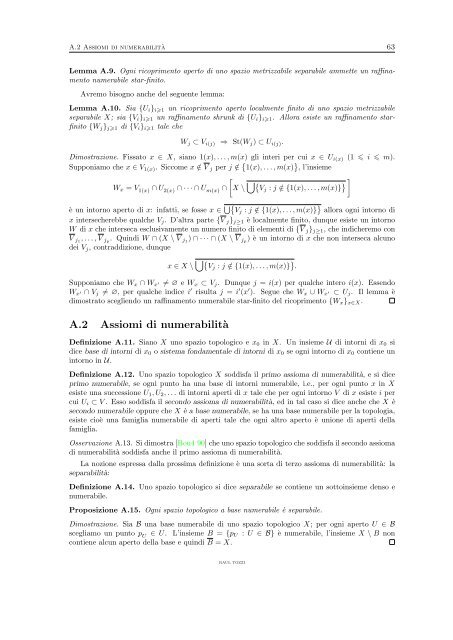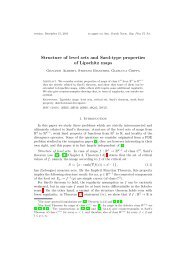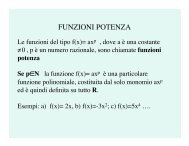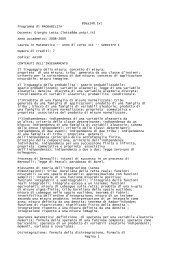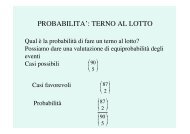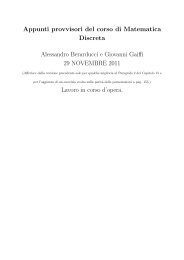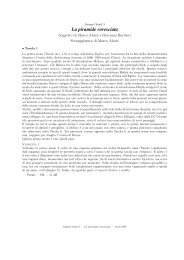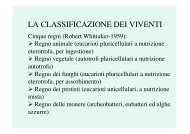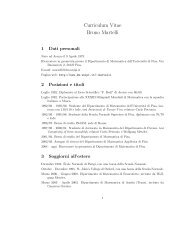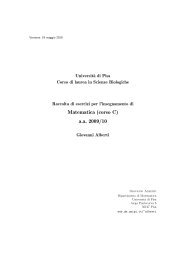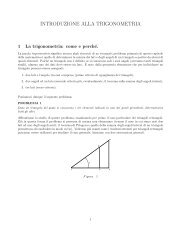Immersioni aperte in dimensione infinita - Dipartimento di Matematica
Immersioni aperte in dimensione infinita - Dipartimento di Matematica
Immersioni aperte in dimensione infinita - Dipartimento di Matematica
Create successful ePaper yourself
Turn your PDF publications into a flip-book with our unique Google optimized e-Paper software.
A.2 Assiomi <strong>di</strong> numerabilità 63<br />
Lemma A.9. Ogni ricoprimento aperto <strong>di</strong> uno spazio metrizzabile separabile ammette un raff<strong>in</strong>amento<br />
numerabile star-f<strong>in</strong>ito.<br />
Avremo bisogno anche del seguente lemma:<br />
Lemma A.10. Sia {Ui}i1 un ricoprimento aperto localmente f<strong>in</strong>ito <strong>di</strong> uno spazio metrizzabile<br />
separabile X; sia {Vi}i1 un raff<strong>in</strong>amento shrunk <strong>di</strong> {Ui}i1. Allora esiste un raff<strong>in</strong>amento starf<strong>in</strong>ito<br />
{Wj}j1 <strong>di</strong> {Vi}i1 tale che<br />
Wj ⊂ V i(j) ⇒ St(Wj) ⊂ U i(j).<br />
Dimostrazione. Fissato x ∈ X, siano 1(x), . . . , m(x) gli <strong>in</strong>teri per cui x ∈ Ui(x) (1 i m).<br />
Supponiamo che x ∈ V1(x). Siccome x /∈ V j per j /∈ 1(x), . . . , m(x) , l’<strong>in</strong>sieme<br />
<br />
Wx = V1(x) ∩ U2(x) ∩ · · · ∩ Um(x) ∩ X \ <br />
<br />
<br />
Vj : j /∈ {1(x), . . . , m(x)}<br />
è un <strong>in</strong>torno aperto <strong>di</strong> x: <strong>in</strong>fatti, se fosse x ∈ Vj : j /∈ {1(x), . . . , m(x)} allora ogni <strong>in</strong>torno <strong>di</strong><br />
x <strong>in</strong>tersecherebbe qualche Vj. D’altra parte {V j}j≥1 è localmente f<strong>in</strong>ito, dunque esiste un <strong>in</strong>torno<br />
W <strong>di</strong> x che <strong>in</strong>terseca esclusivamente un numero f<strong>in</strong>ito <strong>di</strong> elementi <strong>di</strong> {V j}j≥1, che <strong>in</strong><strong>di</strong>cheremo con<br />
V j1 , . . . , V jp . Qu<strong>in</strong><strong>di</strong> W ∩ (X \ V j1 ) ∩ · · · ∩ (X \ V jp ) è un <strong>in</strong>torno <strong>di</strong> x che non <strong>in</strong>terseca alcuno<br />
dei Vj, contrad<strong>di</strong>zione, dunque<br />
x ∈ X \ Vj : j /∈ {1(x), . . . , m(x)} .<br />
Supponiamo che Wx ∩ Wx ′ = ∅ e Wx ⊂ Vj. Dunque j = i(x) per qualche <strong>in</strong>tero i(x). Essendo<br />
Wx ′ ∩ Vj = ∅, per qualche <strong>in</strong><strong>di</strong>ce i ′ risulta j = i ′ (x ′ ). Segue che Wx ∪ Wx ′ ⊂ Uj. Il lemma è<br />
<strong>di</strong>mostrato scegliendo un raff<strong>in</strong>amento numerabile star-f<strong>in</strong>ito del ricoprimento {Wx}x∈X.<br />
A.2 Assiomi <strong>di</strong> numerabilità<br />
Def<strong>in</strong>izione A.11. Siano X uno spazio topologico e x0 <strong>in</strong> X. Un <strong>in</strong>sieme U <strong>di</strong> <strong>in</strong>torni <strong>di</strong> x0 si<br />
<strong>di</strong>ce base <strong>di</strong> <strong>in</strong>torni <strong>di</strong> x0 o sistema fondamentale <strong>di</strong> <strong>in</strong>torni <strong>di</strong> x0 se ogni <strong>in</strong>torno <strong>di</strong> x0 contiene un<br />
<strong>in</strong>torno <strong>in</strong> U.<br />
Def<strong>in</strong>izione A.12. Uno spazio topologico X sod<strong>di</strong>sfa il primo assioma <strong>di</strong> numerabilità, e si <strong>di</strong>ce<br />
primo numerabile, se ogni punto ha una base <strong>di</strong> <strong>in</strong>torni numerabile, i.e., per ogni punto x <strong>in</strong> X<br />
esiste una successione U1, U2, . . . <strong>di</strong> <strong>in</strong>torni aperti <strong>di</strong> x tale che per ogni <strong>in</strong>torno V <strong>di</strong> x esiste i per<br />
cui Ui ⊂ V . Esso sod<strong>di</strong>sfa il secondo assioma <strong>di</strong> numerabilità, ed <strong>in</strong> tal caso si <strong>di</strong>ce anche che X è<br />
secondo numerabile oppure che X è a base numerabile, se ha una base numerabile per la topologia,<br />
esiste cioè una famiglia numerabile <strong>di</strong> aperti tale che ogni altro aperto è unione <strong>di</strong> aperti della<br />
famiglia.<br />
Osservazione A.13. Si <strong>di</strong>mostra [Bou4 90] che uno spazio topologico che sod<strong>di</strong>sfa il secondo assioma<br />
<strong>di</strong> numerabilità sod<strong>di</strong>sfa anche il primo assioma <strong>di</strong> numerabilità.<br />
La nozione espressa dalla prossima def<strong>in</strong>izione è una sorta <strong>di</strong> terzo assioma <strong>di</strong> numerabilità: la<br />
separabilità:<br />
Def<strong>in</strong>izione A.14. Uno spazio topologico si <strong>di</strong>ce separabile se contiene un sotto<strong>in</strong>sieme denso e<br />
numerabile.<br />
Proposizione A.15. Ogni spazio topologico a base numerabile è separabile.<br />
Dimostrazione. Sia B una base numerabile <strong>di</strong> uno spazio topologico X; per ogni aperto U ∈ B<br />
scegliamo un punto p U ∈ U. L’<strong>in</strong>sieme B = {pU : U ∈ B} è numerabile, l’<strong>in</strong>sieme X \ B non<br />
contiene alcun aperto della base e qu<strong>in</strong><strong>di</strong> B = X.<br />
RAUL TOZZI


